Temple Of Literature
Description
Literature Temple Hanoi (Văn Mieu) is a Confucius temple in Hanoi, northern Vietnam. The Imperial Academy, Vietnam’s first national university, is also housed in the temple. The temple was constructed around 1070 during the reign of Emperor Ly Thanh Tong. It is one of a number of temples in Vietnam dedicated to Confucius, sages, and professors. The shrine is located to the south of Thang Long’s Imperial Citadel. Offering rituals, study sessions, and the severe exams of the Đại Việt took place in the many pavilions, halls, sculptures, and stelae of doctors. The temple can be found on the reverse of the 100,000 Vietnamese dong banknote. Calligraphists will gather outside the temple shortly before the Vietnamese New Year celebration Tet to write wishes in Chữ Hán. The artworks are presented as gifts or used to decorate homes for important occasions.
The Temple of Literature in Hanoi (Văn Miếu – Quốc Tử Giám) is a remarkable example of well-preserved traditional Vietnamese architecture devoted to Confucius and honoring Vietnam’s greatest intellectuals. This is one of Hanoi’s most scenic tourist sites, located to the south of the Imperial Citadel of Thang Long. The Temple of Literature, as Vietnam’s first national university, is a place of learning rather than a religious landmark.
- Entrance fee: Adults: 30,000 VND (~US$ 1.3) for Vietnamese and foreigners, Students: 15,000 VND (~US$ 0.7) (student card required), Children under 15: Free
- Dress code: no tank-top or miniskirt allowed, always take off your hat when being in the sanctuary area.
- Opening hours: every day. In summer ( From April to October) : 07:30-17:30. In winter (From October to April) : 08:00-17:00
Architecture of The Temple of Literature
This location is well-known as one of Hanoi’s most gorgeous tourist attractions. Tourists visiting the temple will have the opportunity to see ancient buildings from the Ly and Tran dynasties, as well as the respected institution that has seen hundreds of physicians graduate and has now become Vietnam’s tribute to education and literature. Several traditional-style Vietnamese architecture features, such as ironwood pillars and walls, terracotta tiles, curved shoes shape roof tiles according to the art style of the Le Nguyen dynasty, many ancient trees (hundreds of years old trees), or even pavilions, courtyards, and passageways once used by royalty, were preserved.
The temple layout is comparable to that of Confucius’ birthplace, Qufu, Shandong. It spans about 54,000 square metres (580,000 square feet), comprising the Văn lake, Giám park, and internal courtyards encircled by a brick wall. Four towering pillars stand in front of the Great Gate. Two stelae on either side of the pillars instruct riders to dismount.
The gate leads to three roads that lead throughout the compound. The central road was designated for the monarch, and above it is a large bronze bell. The way to the left is designated for administrative Mandarins, while the path to the right is designated for military Mandarins. The site’s interior is separated into five courtyards. The first two courtyards are tranquil spaces with old trees and manicured grass where academics may unwind away from the hustle and bustle of the outer world.
The bell placed above the main gate was added to the Văn Miếu in the 19th century to indicate the arrival of an important person. Monks were the only ones who could touch the bronze bell. Several designs can be seen on the bell, including an outline of a phoenix, which signifies beauty, and a dragon, which represents power. The Emperor and Queen are represented by both of these insignia. A bell may be found in every pagoda in Vietnam.
First Courtyard – “Đại Trung Môn” (The great middle gate)
From the Great Portico, the first courtyard extends to the Đại Trung, which is surrounded by two smaller gates: the Đạt Tài gate and the Thành Đức gate.
The “Van Mieu Mon” Main Gate was constructed in traditional Vietnamese fashion. A bell that used to ring at the top of the gate to indicate an important person was entering used to be there. Only monks were permitted to handle the bell because it was made of bronze. Numerous designs, including a phoenix signifying beauty and a dragon signifying power, can be seen on the bell. These pictures stand in for the Emperor and Queen in Vietnamese tradition.
Travelers arrive at the Great Middle Entrance “Dai Trung Mon” after crossing the Temple of Literature’s main gate.
The name Đại Trung Môn (The big middle gate) is derived from two important Confucian texts: Đại Học” (Great learning) and “Trung Dung” ( The Doctrine of the Mean). On the right and left sides of Dai Trung Gate are two smaller gates named Dai Tai (Achieved Talent) and Thanh Duc (Achieved Virtue), indicating the importance of education and training. Due to the old Eastern belief that the left side is more essential than the right (Confucius’s perspective), this arrangement implies that virtue is more important than talent.
The carp sign on the top of the Dai Trung Gate, which is derived from an ancient Chinese folklore, is another defining characteristic of the structure “Once once a time, the God organized a contest in which participants were required to swim upstream against the river’s strong current. A number of fish participated in this contest, but only a handful are able to make the final leap over the waterfall. If a carp makes the jump successfully, it can turn into a strong dragon.” To become government officials, Vietnamese students must overcome numerous obstacles, including as passing the Regional examination (Hương examination), National examination (Hội examination), and Royal examination (Đình examination). If you proceed inside, you will notice that the carp symbol has been replaced with dragon emblems, indicating a student’s advancement in social status.
Second Courtyard – “Khuê Văn Các” (Constellation of Literature Pavilion)
The second courtyard is frequently referred to as the big center courtyard or courtyard of great success. It boasts the 1805-built Khuê Văn pavilion, a unique architectural achievement that has become a symbol of modern-day Hanoi. The Khuê Văn pavilion is built on four stone stilts that have been whitewashed. At the apex is a crimson roof with two circular windows and an intricate design. A bronze bell hangs from the roof inside the structure and is rung on auspicious occasions. The pavilion’s preservation of several lovely lyrical words lauds Vietnamese traditional culture. In proximity to the Khuê Văn pavilion are the Suc Văn and Bi Văn gates. These two gates are dedicated to both the substance and form of literary beauty. In the first and second courtyards, there are topiaries (sculpted shrubs) that resemble the 12 animals of the zodiac.
It is not a large structure, yet its architecture is distinctive and elegant. At the top of the structure is a red hue with two circular windows and a roof that is a blend of a circle and a square. In Vietnamese culture, the circle represents the sky and the square represents the earth; their combination indicates yin and yang balance. In addition, the name Khue Van, which is derived from the brightest star in the sky, embodies the hope for the development and prosperity of Vietnam’s education and culture.
In the past, the constellation of Literature Pavilion was where the monarch and his officials met to debate and examine the writings of outstanding students who had passed the national examination. It is now regarded as the symbol of Hanoi, the capital of Vietnam.
Third Courtyard – Thien Quang well and Doctor Stelae
The third courtyard is accessible via the Khuê Văn pavilion. The Thiên Quang well may be found in the third court. On either side of the well are two large rooms that contain the temple’s treasures.
This well is one of the primary things that maintain the serene ambiance of the temple and help purify the thoughts of individuals. In addition, it served as a mirror for individuals to adjust their attire before entering the holiest portion of the complex. Thien Quang’s name, which translates to “light from the sky,” implies the expectation that students will receive the elite from the sky, improve their knowledge and virtue, and serve their country.
In 1484, Emperor Lê Thánh Tông initiated the construction of the stone stelae. To honor genius and encourage study, he created 116 steles of turtles carved from blue stone with ornate designs. The Turtle (Quy) is one of the nation’s four sacred animals, along with the Dragon (Long), Unicorn (Ly), and Phoenix (Phượng). The turtle represents longevity and sagacity. With the passage of time, the size and shape of the turtle altered.
The doctors’ steles are an important historical resource for the study of Vietnamese culture, education, and sculpture. 82 stelae survive. They display the names and birthplaces of 1,307 individuals who passed 82 triennial royal examinations. Between 1442 and 1779, the Lê dynasty administered eighty-one examinations while the Mac dynasty administered one. The ancient Chinese carvings on each stele extol the monarch’s virtues and explain the purpose of royal examinations. They also document the mandarins responsible with organizing the examinations. It was once popular for visitors to rub the heads of the stone turtles, but today there is a fence to discourage this in order to preserve the turtles.
For the study of Vietnamese philosophy, history, culture, education, society, and sculpture, they are a great historical resource. In 2011, the stelae were included on the UNESCO Memory of the World Register.
Fourth Courtyard – “Đại Thành Môn” (The gate to great success), and “Đại Bái Đường” (House of Ceremony)
The entrance to the fourth courtyard is the Đại Thành gate. Two smaller gates, the Kim Thanh gate and the Ngọc Chấn gate, flank the main entrance. This courtyard is the complex’s ceremonial hub.
Two halls are located on each side of the ceremonial fourth courtyard. Their initial function was to serve as altars for the seventy-two most revered pupils of Confucius and Chu Văn An (a rector of the Imperial Academy). The House of Ceremonies Đại Bái Đường resides in the center of the fourth courtyard. The following structure is the Thượng Điện, where Confucius and his four closest followers Yanhui, Zengshen, Zisi, and Mencius are venerated. Additionally, the sanctuary contains altars for ten revered philosophers. These pavilions are designed in the early 19th century style. A modest museum exhibits inkwells, pens, books, and other personal artifacts belonging to former pupils of the temple.
There is a standard altar in the center of the sanctuary in every Vietnamese household. The altar is always placed in the house’s most sacred and central location, where ancestor worship takes place. Five primary elements, including Metal, Wood, Water, Fire, and Earth, filled with offerings and incense must be present on the altar.
Each side of the altar is decorated with a pair of cranes and turtles. They are regarded as close companions and express a yearning for harmony and eternity.
Fifth Courtyard – “Nhà Thái Học” (The Imperial Academy)
Emperor Lý Nhân Tông ordered the construction of an imperial academy as the fifth courtyard in 1076. As students, literate Mandarins were chosen. The academy was expanded in 1236 and renamed Quốc Tử Viện, then Quốc Học Viện. It was renamed Thái Hc Vin under the Lê dynasty and greatly developed. The Minh Luân home, west and east classrooms, a storeroom for wooden printing blocks, and two sets of three 25-room dormitories were also part of this expansion. The Khai Thánh shrine was established to honor Confucius’ parents. During the First Indochina War in 1946, the courtyard was demolished. The fifth courtyard was rebuilt on the site of the original “Imperial Academy” in the year 2000. It recognizes Vietnamese talents, national traditions, culture, and education. The new fifth courtyard was designed in accordance with the temple’s surrounding attractions using traditional architecture. The front building, the back building, the left and right buildings, a bell house, and a drum house were all completed. The Thái Hoc courtyard takes about 1530 square meters of the temple’s overall area of 6150 square meters. The front building serves several purposes. Ceremonies in commemoration of cultural academics, as well as scientific and cultural activities, are organized from the front building. The back structure comprises two levels. The bottom level features a statue of Chu Văn An (the academy’s rector) as well as exhibits from the temple and the academy, including a display on Confucian education in Vietnam.
The upper floor is dedicated to the three monarchs who made the greatest contributions to the establishment of the temple and the academy: Lý Thánh Tông (1023-1072), who founded the temple in 1070, Lý Thánh Tông (1066-1127), who established the Imperial Academy, and Lê Thánh Tông (1442-1497), who ordered the erection of the turtle stone stelae of doctor laureates in 1484.
Square buildings on either side of the back building house a drum and a bronze bell. The drum measures 2.01 meters (6 feet 7 inches) wide, 2.65 meters (8 feet 8 inches) high, has a volume of 10 m3, and weighs 700 kilograms (1,500 lb). The bell was cast in 2000 and measures 2.1 by 0.99 meters (6 ft 11 in by 3 ft 3 in).
History Of Temple Of Literature
The temple was originally established around 1070 and then rebuilt during the Tran dynasty (1225–1400). The temple has preserved historic architectural designs from numerous dynasties as well as priceless artifacts for almost two centuries despite wars and disasters. Significant renovations were carried out in 1920, 1954, and 2000.
The “Quốc Tử Giám” or Imperial Academy, Vietnam’s first university, was founded inside the temple in 1076 under the reign of Lý Nhân Tông to educate the country’s officials, nobles, royalty, and other members of the aristocracy. From 1076 to 1779, the university was open for business. The rulers of the Nguyen dynasty erected the Huế capital in 1802, where they also founded a new imperial academy. The Hanoi temple’s academy lost its importance and became into a Hoài Đức District school.
The Văn Miếu – Quốc Tử Giám was recognized as a Monument historique in 1906 while it was a part of the French protectorate. Parts of the temple were demolished by the French between 1945 and 1954 to make more space for the Saint Paul Hospital, which was at capacity during the war. Restoration campaigns were carried out in 1920 and 1947 by the École française d’Extrême-Orient (French School of the Far East).
How To Get To The Temple Of Literature
It is around 3 kilometers from Hoan Kiem Lake and takes approximately 10-15 minutes to drive there. There are several modes of transportation available, including bus, taxi, hired motorbike, cyclo, and walking. A private car/minivan with an experienced tour guide is highly suggested for the most comfortable and entertaining experience.
If you are traveling by motorcycle, you can take the following route: from Hoan Kiem Lake, take Le Thai To street, and then turn right onto Trang Thi street. After that, continue straight on this route until you reach Dien Bien Phu street, where you will turn left onto Tran Phu street. Visitors should turn left onto Chu Van An street from Tran Phu street. The Temple of Literature in Hanoi is then reached by turning right down Nguyen Thai Hoc street. When riding by motorcycle, visitors should keep in mind that the road around Van Mieu Quoc Tu Giam is one-way. In addition, you can take a Hanoi car rental service or a full-day Hanoi city trip to visit the Hanoi Temple of Literature. You can also take a bus with the numbers 02, 23, 25, 38, 41, or 49. Traveling by bus is not only secure and inexpensive, but it also allows travelers to appreciate the lovely surroundings of Hanoi. However, unlike a private automobile, this vehicle is not as flexible in terms of time and route.
Gallery / Photos
Working Hours
- Monday 8:00 AM - 5:00 PM
- Tuesday 8:00 AM - 5:00 PM
- Wednesday 8:00 AM - 5:00 PM
- Thursday 8:00 AM - 5:00 PM
- Friday 8:00 AM - 5:00 PM
- Saturday 8:00 AM - 5:00 PM
- Sunday 8:00 AM - 5:00 PM

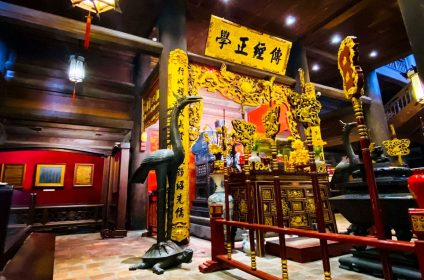
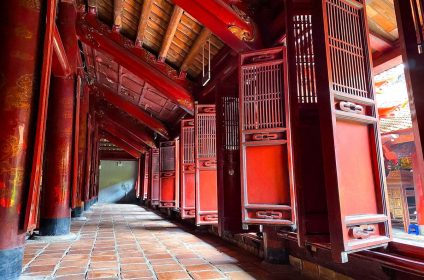
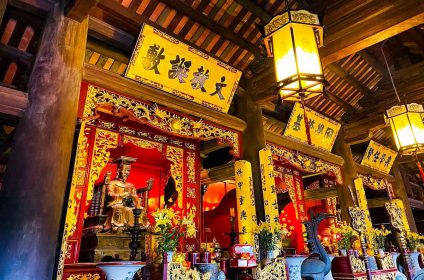
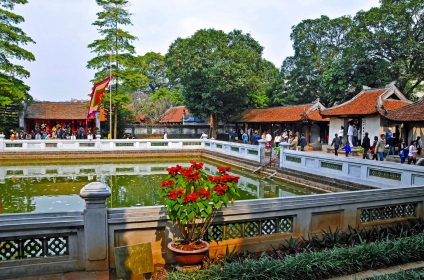
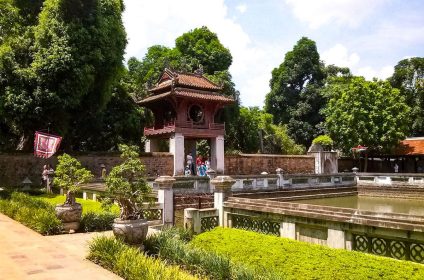
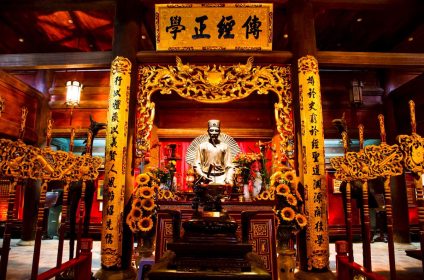
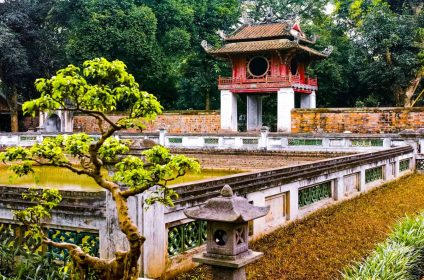
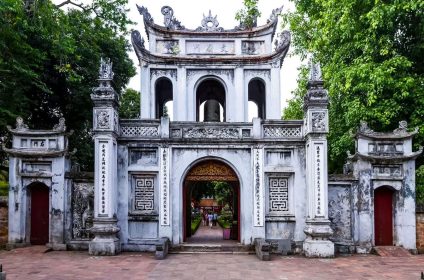
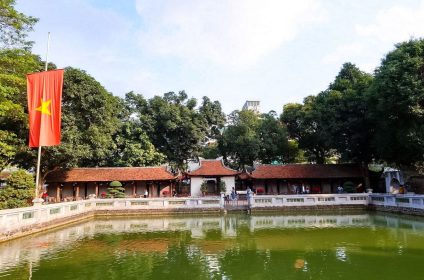
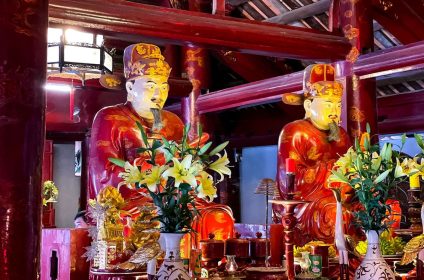
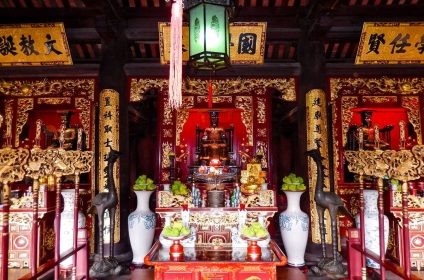
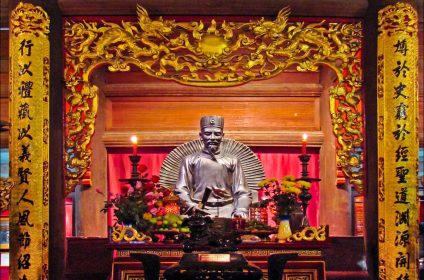
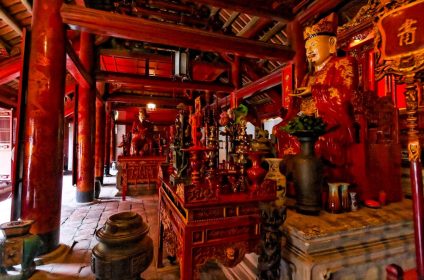
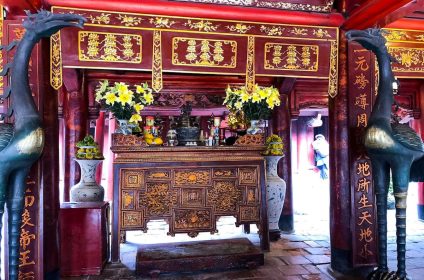
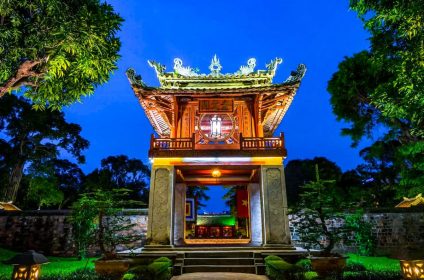
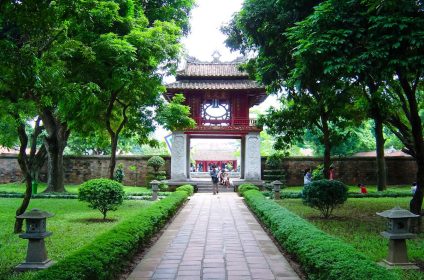
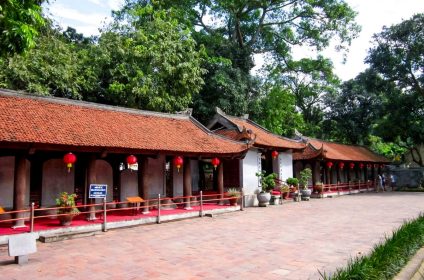
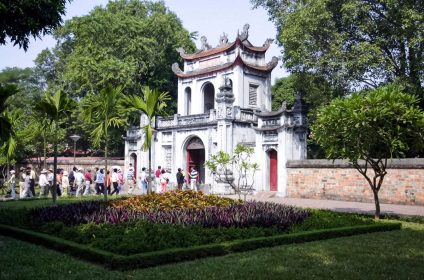
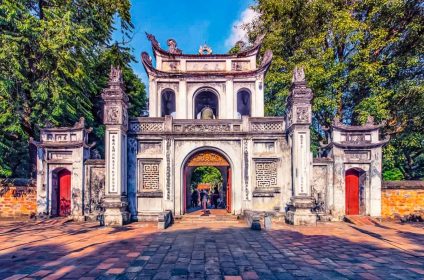
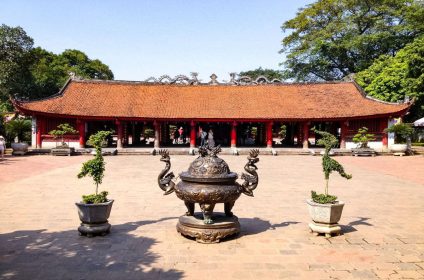

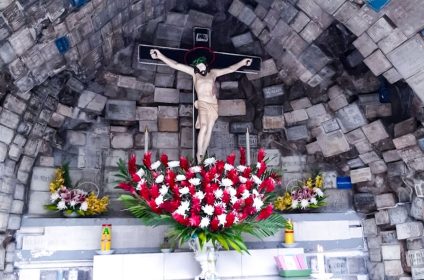
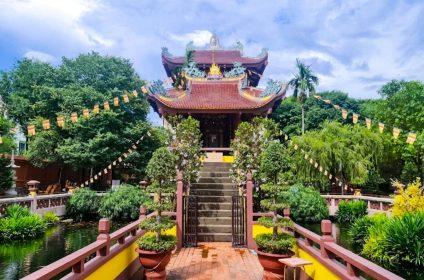
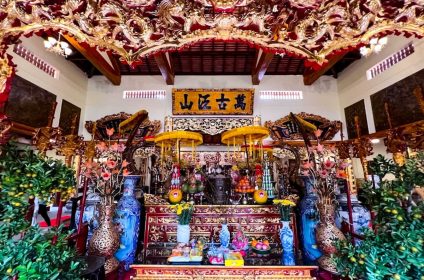
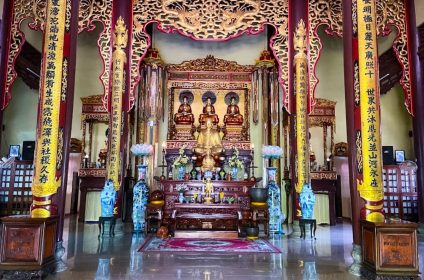
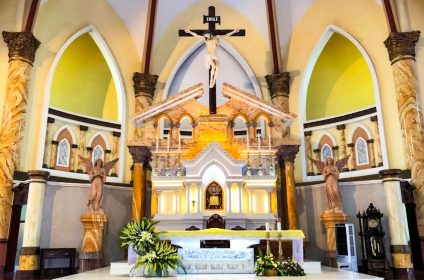










Add Review